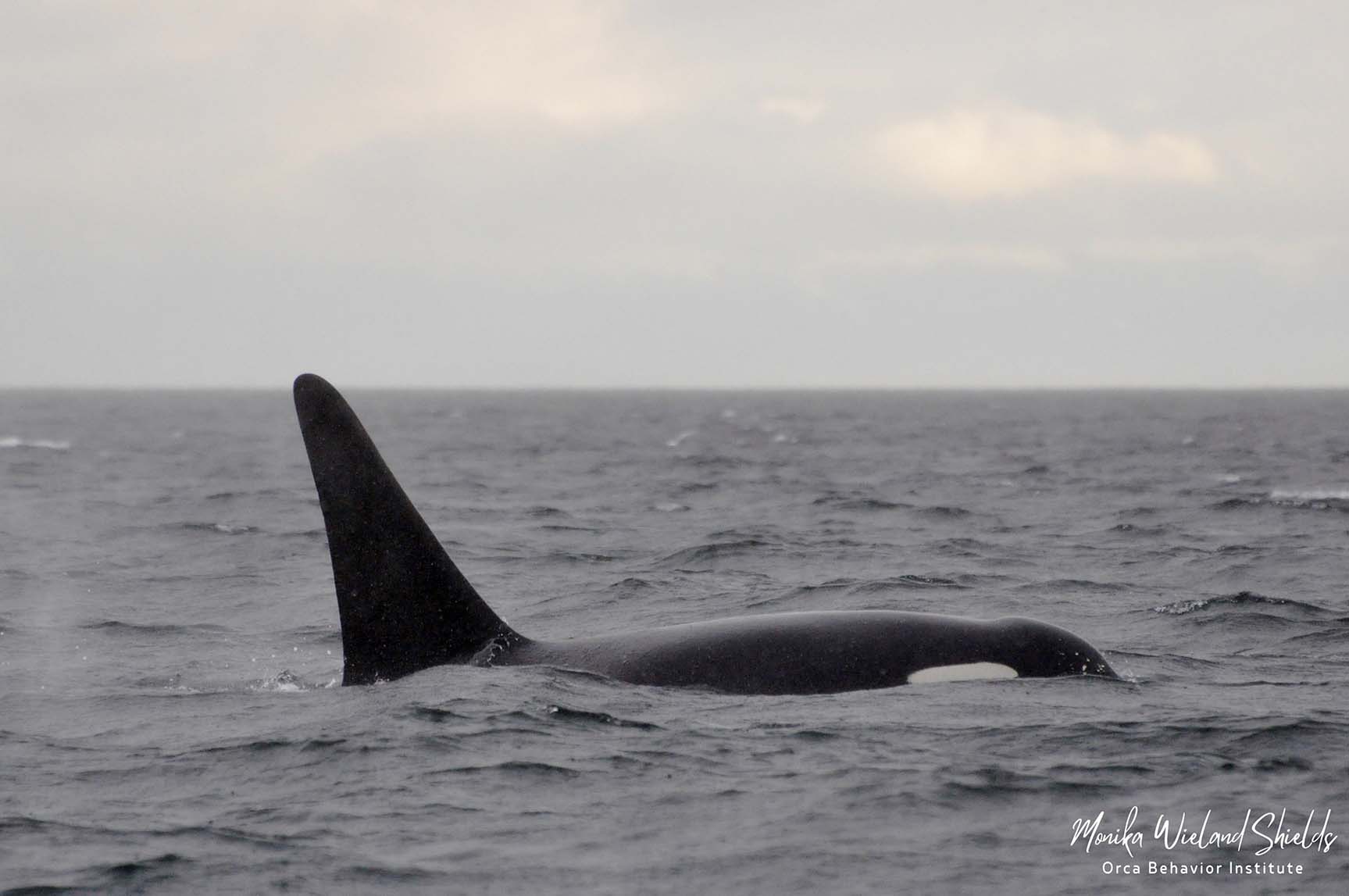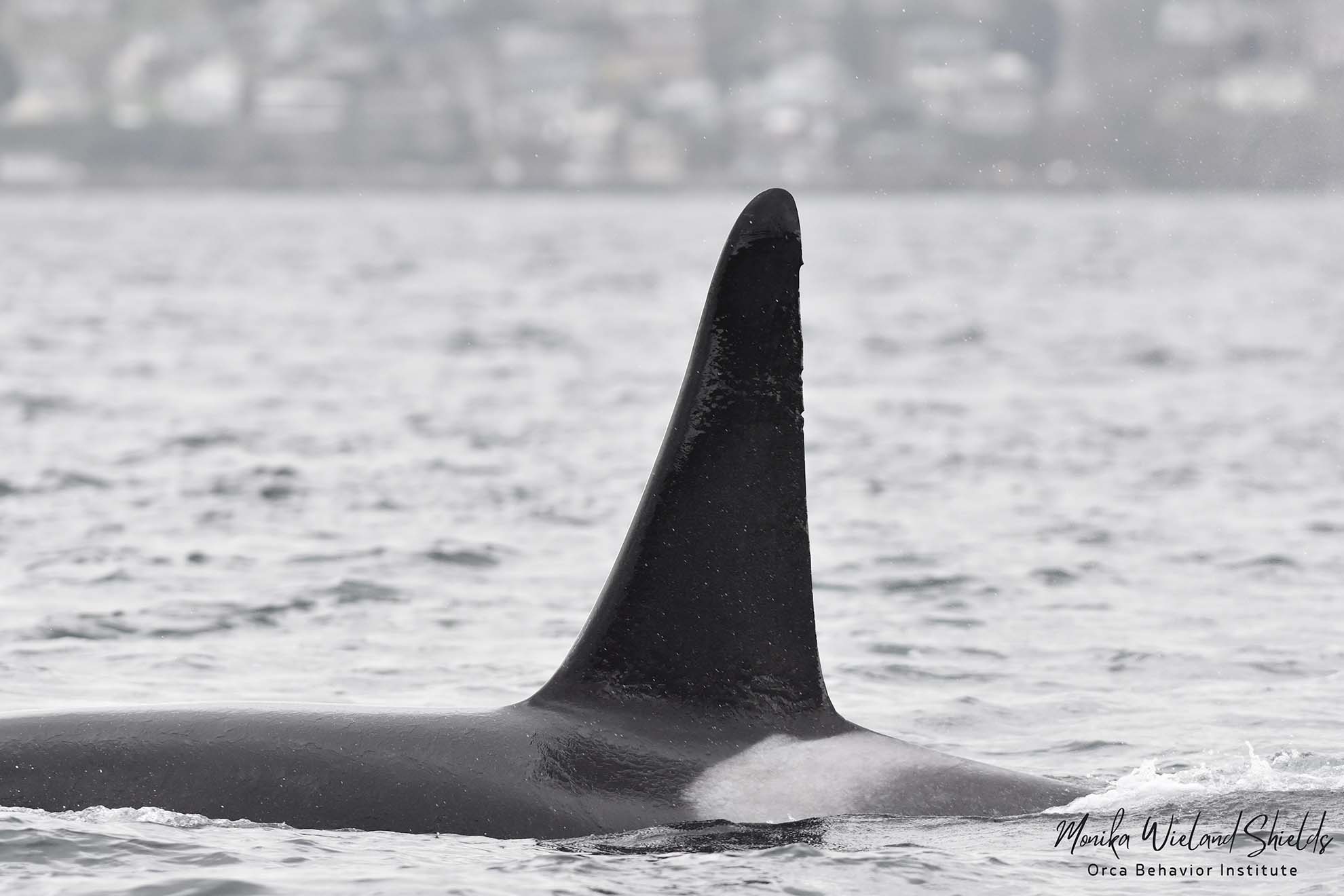
K26 ~ Lobo
At this point he's been gone over a year, but the loss of K26 Lobo still hasn't fully sunk in for me. Almost since I've known them, the K14s have been synonymous with "4 whales" , and in my mind it's been a difficult adjustment to make. Mom K14 Lea, older brother K26 Lobo, sister K36 Yoda, and younger brother K42 Kelp: always a tight family, rarely spending time apart from one another. If I ever saw Lea, I knew to look for Lobo right by her side.
%20and%20K26%20Lobo%20(right).jpg)
Lobo sprouted shortly after I got to know the Southern Residents, so is one of the first males I got to see grow up. I've always thought of him as having one of the most classic resident killer whale dorsal fins: tall, rounded, and for most of his life, free of any blemishes. In reality, not many males have that perfect classic shape, so it made him relatively easy to pick out from the crowd.

In addition to his dorsal fin, he had very characteristic saddle patches with a dip and a bump, definitely unlike anybody else in K-Pod.

Lobo and the K14s will always hold a special place in my heart because of their unique social patterns in the summer of 2015 which is the year we first started collecting data for the Orca Behavior Institute. We had many encounters that summer with the unique combination of J2 and the J14s, the J19s, L87, and the K14s, a group of 14 whales that bizarrely included members of all three pods. Those were the summer days (some of the very last days) when we could head out first thing in the morning from Snug Harbor and travel down the west side of San Juan Island and have a decent shot of finding Southern Residents. We had a handful of memorable encounters that summer that unfolded in just that fashion, but one in particular takes the cake. We ended up on scene with the J14s, J19s, and K14s at Salmon Bank in glassy calm seas. The lighting was stunning, dorsal fins reflecting in long rippling shadows on the water that reached towards us. Out of nowhere, the whole group started to get surface active. It began with breaches from J19 Shachi and K14 Lea, and was followed by this half breach by K26 Lobo. This remains one of my all time favorite Southern Resident shots that I've ever taken in 20+ years.

By 2021, those predictable west side SRKW days were gone. It was, up until that point at least, the lowest summer for Southern Resident presence in the Salish Sea that we had on record. I personally didn't see K-Pod at all over the first 8 months of the year for the first time ever. By the time I did encounter them in the final months of the year, K26 was sporting some new nicks along the trailing edge of his dorsal fin. Gone was that clean, classic look I associated with him, but he would remain very distinct.

The last time I saw K26 was in the spring of 2024; he would later go missing that summer. By this point, his younger brother K42 Kelp, who I remember popping up as a newborn in sharp contrast to the towering fin of his older brother in 2008, had grown up to look almost exactly like him. When I see K-Pod now, I always do a double take when Kelp surfaces, because to my eye he's the spitting image of Lobo before he got the notches. In addition to his younger brother, Lobo's legacy will also live on in J51 Nova. A 2023 paper updating Southern Resident genetics confirmed Lobo as the father of J51.
J61
In December of 2024, J35 Tahlequah was seen with a newborn female calf, her first since the birth of J57 Phoenix in 2020. We all had so much hope that she would be able to successfully raise a daughter after she lost one in 2018, famously carrying the calf's body for 17 days before letting it go. There was early concern for this calf, though, as it was reported as looking very energetic during the first encounters. Sadly, less than two weeks after she was first seen, J61 had passed away, and J35 was again left to carry the body of her deceased daughter. Given the time of year (and its associated weather and lack of eyes on the water), we know less about the details of what happend with J61, and it received much less in the way of media attention, but we do know that J35 was carrying J61 for at least several days, when most other mothers in this situation let the body go after a matter of hours.
J64 + unnamed calf of J36
In September of 2025, while J-Pod was in Puget Sound, a new calf was documented traveling with the J16s. Somewhat bizarrely, and in hindsight perhaps concernedly, the calf was initially flanked by grandmother J16 Slick and uncle J26 Mike instead of traveling in echelon position to the whale determined to be its mother, J42 Echo. While the calf survived the first critical few days, it failed to start fully filling out, and by the end of October, per the Center ofor Whale Research, was no longer traveling with J-Pod and is presumed deceased.
The J16 matriline just can't seem to catch a break, as less than a week prior to the birth of J64, Echo's sister J36 Alki had also given birth, but to either a stillborn or newborn that died shortly after birth, as the little one was only seen deceased and being carried by its mother. Since the birth of J42 in 2007, no calf born into the J16 matriline is still alive today. J42 is known to be the result of direct inbreeding between her mom Slick and older brother Mike, raising questions about her fertility and the health of the overall matriline as a whole. J16 is now post-reproductive, but lost her last calf, J50, in 2018. J36 was the mother of J52 Sonic, who was born in 2015 and was also fathered by her older brother. Sonic passed away in 2016. Since then, J36 has lost pregnancies in 2019, 2021, and 2023, making the calf she lost in September the fourth failed pregnancy in six years.
New Additions
While this annual post is primarily about honoring the whales we have lost over the previous year, I think when possible it's important to end it on a positive note by also celebrating the new additions to the Southern Resident community. Since my last writing, that includes two new calves in J-Pod: J62 and J63.
J62 was first seen in December 2024. Her mom is J41 Eclipse, and J62 is her third known calf. J63 was first seen in April 2025 and is the first documented calf of J40 Suttles. Eclipse and Suttles were born within a year of each other, and as youngsters spent a lot of time playing together. I always imagined them growing up and having calves together, but despite being very calf-focused for all of her adult life, J40 is a much older first-time mom than J41. It somehow feels very fitting to me, however, that they've both had daughters within a year of one another.
If I can anthropomorphize for a bit, the personalities of these two youngsters feel very different to me. When I've seen J62, she is almost always tucked right in beside mom and "on her best behavior". J63, on the other hand, has looked like a bit of a wild child! It's been a long time since I've seen a calf breach as often as her, and despite being less than 6 months old, she's already taken to wandering a little ways from mom's side to explore and play. I so look forward to seeing if these early observations of their personalities hold true in the year to come, and if they start to play together as 1 and 2 year-olds just like their moms did.


